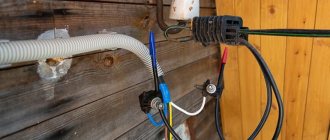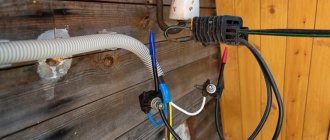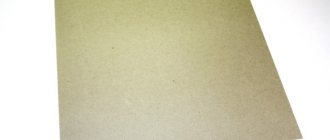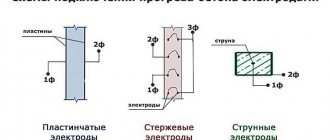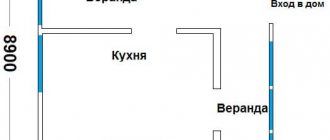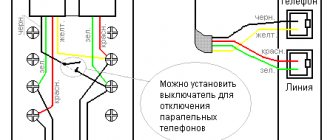Self-supporting insulated wire (SIP) has recently become the most popular cable product for installing electrification networks of private houses, cottages and other real estate. Before its appearance on the market, various types of insulated or non-insulated wires and cables were mainly used to create overhead power lines, which had a number of significant disadvantages. SIP is completely devoid of all these disadvantages, which is why its popularity is so high. But the method of connecting a self-supporting wire to each other and to other types of cable is not always clear to the average user!
In the process of electrifying private houses, cottages and other buildings, the question always arises of how to connect self-supporting insulated wires with copper cable, other types of wires, and also with each other. The reliability and performance of the entire electrical network of the facility depends on this operation. Failure to comply with installation rules can lead not only to loss of contact between individual parts of the building's energy supply system, but also to more serious negative consequences.
SIP wires are made of aluminum. This metal is subject to rapid oxidation in air and a film with high resistance to electric current is formed on its surface.
Copper conductors do not have such a negative property, so their direct connection with aluminum conductors can lead to loss of functionality of the entire cable line. In this article we will consider the following issues: connection and installation of SIP wires with different types of cable products, as well as their connection to each other.
What is important to know
A typical situation where it may be necessary to connect a self-supporting insulated wire with a copper cable occurs when connecting a private house or cottage to a power line made with a self-supporting insulated wire. Here, first of all, you must comply with the received Technical Conditions issued by the energy supply organization. This document usually contains detailed information on how and with what conductor the power circuits to the meter must be connected. It may also indicate how to connect the wires. As a rule, the requirement is that the conductor from the overhead line to the metering panel be visible and solid.
Connecting SIP to the cable on the facade
When directing the wiring from the support to the facade of the building, the cable can be secured using reliable and wear-resistant anchors. You can connect power supply wires and create a reliable network by using a piercing clamp. The technology we describe will help you quickly, safely, affordably and reliably solve the problem of energy supply to a private home or buildings located next to it. The advantages of this type of connecting component also include ease of installation, affordable cost and resistance to harmful environmental influences.
Connection options
Depending on the location of the metering board, options arise to connect the SIPs to each other or to a wire of another type. Next, we will consider in what situations and how exactly it is necessary to connect a self-supporting insulated wire with other conductors.
The metering board is located on the line support
The connection of the line to the metering board is made with a solid conductor, which is connected directly to the input circuit breaker in the board. To connect the conductor to the line, you should use a standard piercing clamp specifically designed for SIP lines. A version of such a connector is shown in the photo below. The piercing clamp is designed for connecting taps to main lines. This instance can connect a line with a cross-section from 16 mm 2 to 120 mm 2 with a tap with a cross-section from 6 mm 2 to 50 mm 2. SIP or ordinary copper cable, for example VVG, can be used as a tap.
The main compression elements are two steel plates with pointed teeth, which, when the mounting bolt is tightened, come closer to each other and, piercing the insulation of the line and soldering wires, ensure reliable contact and tightness of the fastening point. The bolt is tightened until it breaks, designed for a certain compression force. The design is disposable.
The video below clearly shows how to use piercing squeezes:
If the connection from the metering panel on the pole to the house is made using SIP, standard fittings should also be used for its installation. The best option is to run the wire directly into the distribution box, connecting it to the input circuit breaker in the panel. In this case, it will not be necessary to fasten it to the cable. If for some reason the SIP and copper cable need to be connected, this can be done on the street, at the entrance to the house. The connection can be made with a piercing clamp. In addition, the connecting installation can be performed using die compressions, which are called nuts for their shape. You can learn more about the nut clamp from our article.
Both types of clamps can connect current-carrying conductors made of different materials, for example, a self-supporting insulated conductor can be connected to SIP, VVG, VVGng, AVVG or AC. This is made possible by the design of the connector, which ensures that there is no direct contact between aluminum and copper. Each of the connected conductors is in contact only with the steel plates.
How to use nuts is described and shown in the video:
The connection of SIP with uninsulated wires (bare) is carried out using a clamp of a special design that does not have sharp teeth on the side where the bare wire is attached. This type of compression is shown in the photo below:
It remains to add that it is not allowed to twist copper and aluminum wires together due to the occurrence of electrochemical corrosion! This issue is discussed in more detail in the article: https://samelectrik.ru/kak-soedinit-alyuminievyj-provod-s-mednym.html.
The metering board is located on the wall of the house
In this case, the tap, connected to the main line by a seal clamp, is inserted directly into the metering panel and connected to the input machine. If the tapping conductor is a self-supporting insulated wire, anchor clamps are installed on the line support and on the wall of the house to secure the wire. If a copper cable is chosen to connect the line and the metering board, it is necessary to tension a steel cable on which the cable should be secured, since it is not designed for tensile loads.
Connecting SIP and copper cable in this option may be necessary if there are several buildings on the site and power distribution through them is carried out using SIP. Installation in this case can be performed in the same way as described above, using a piercing or die clamp.
Sometimes you can see how the connection of a self-supporting insulated wire with a copper cable is made with a sleeve that requires subsequent crimping.
This is unjustified for several reasons:
- Installation of sleeves requires special equipment.
- MJPT sleeve clamps are designed for end-to-end connection of SIP wires of the same cross-section during repair or installation of trunk lines. The technology used ensures the mechanical strength of the bonding point, which is necessary for the repaired wire to maintain its load-bearing properties. The connection of the cable to the SIP at the house power input does not carry a mechanical load.
- Bare copper sleeves are used to restore the cores of a conventional cable, after which a coupling is mounted in this place.
The connector installation technology is shown in the video:
Connecting SIPs to each other
The methods of such connection depend on the purpose being pursued. There can be two types of fastening of wires to each other on a support:
- connecting the main line end-to-end during repair or installation, when the length of the solid wire is not enough;
- branch from the main line to power the consumer.
In the first case, MJPT clamps are used, this was mentioned above. In the second case, it is enough to connect the wires with a piercing clamp.
Do-it-yourself electrical wiring in a wooden house. Technical recommendations.
From pillar to house.
The cable can be stretched from the pole to the house in two ways:
1 . Underground. Safe but expensive. Requires approval from the power supply organization.
Principle: The cable is pulled through a metal pipe laid underground at a depth of at least 0.8 meters.
2 . Air. The most common. Inexpensive and simple. Therefore, more about it.
Principle: Pulling through the air. Usually SIP type wire is used
What is SIP?
SIP is a self-supporting insulated wire with cross-linked polyethylene insulation. Used for laying overhead power lines. The insulation material makes it resistant to UV radiation and temperature changes. SIP manufactured according to GOST has a service life declared by the manufacturer of at least 25 years (usually 40-45, depending on the manufacturer!)
How to stretch SIP?
The most popular cable is SIP4. No support cable is required for its installation.
1. A hole is made in the wall of the house into which a metal pipe (sleeve) is driven. A copper cable is pulled through it, which will go from the input point to the switchboard. (It is prohibited to lay SIP in the house!)
2. Not far from the pipe, a hook is attached to the wall of the house.
3. The SIP is fixed in the anchor clamp and the clamp is hooked onto the hook.
4. The SIP is connected to the copper cable using hermetically sealed clamps.
For greater reliability, a sealed plastic box is secured at the point where the copper cable exits. Those. a metal pipe enters the box from the rear wall. The ends of the SIP are also inserted into the box through sealed collet connectors. The connection between SIP and copper cable is carried out inside the box. This option is preferable. But it is not prohibited even without boxing, as in the illustration.
How to connect SIP and copper cable.
SIP and VVGng (VVGng-LS, NYM) are connected using sealed cable clamps. The tightness prevents oxidation of conductors at the contact points. This significantly reduces the likelihood of a short circuit.
From input to switchboard.
Which cable to choose? VVGng, VVGng-LS or NYM?
All these cables are designed for permanent installation. They have copper conductors insulated with PVC plastic. The outer shell is also made of PVC.
Chalk-filled does not mean that chalk is added to the insulation. Think for yourself what will happen if you add chalk to plastic, and what kind of insulation it will be. The bottom line is that the finished veins are rolled in a chalk mixture, and only after that they are placed in the outer shell. This increases the fire resistance of the cable and prevents sticking of cores.
VVGngLS - not only does not support combustion, but also emits a minimal amount of hazardous substances when heated. This cable is recommended for installation inside wooden houses. It can be flat or round. Flat is cheaper. The round one is more convenient to lay. Suitable for group laying.
ATTENTION! Not to be confused with NUM or NUM. This cable is not VDE certified! It is clear that it costs less. There is no reason to consider this cable bad. But he does not have a certificate confirming his “goodness”. So, choose for yourself.
The main difference between NYM and VVGng is the three-layer shell. Between the core insulation and the outer sheath there is a filler made of extruded rubber mixture. This layer increases the fire resistance of the insulation. It also reduces the tension between the outer sheath and the cores, increasing the mechanical strength of the cable. Please remember that the NYM cable is intended for single installation only.
There is a little trick: You can lay several cables side by side, but each in its own corrugation. This is not considered a group gasket.
From the entry point to the switchboard, the cable is pulled in a plastic corrugated pipe (corrugated). The corrugated pipe is made of fire-resistant plastic and serves as additional protection against fire.
In walls and floors, the cable is pulled in thick-walled metal pipes (sleeves). The diameter of the pipe is selected based on the size of the cable. It should be remembered that after laying the cable, at least 40% of the pipe space should remain free. The thickness of the pipe walls is regulated.
This measure has practical meaning:
- Fire protection. (This is the main thing. Where would there be without fire protection in a wooden house.)
- Protection of the cable from mechanical damage at entry points where the probability of cable damage is highest (even in corrugation).
- Protecting the cable from rodents. (“Do you see a gopher? - No. - But there is one.” Rodents - that’s what they are.)
By the way, if the distance is small (2-2.5 meters), you can lay this entire section in a metal pipe. If it is large, then you will get two problems:
- The high cost of the pipe itself.
- The difficulty of pulling it out and placing it.
If difficulties don’t scare you, then go for it. The reward will be absolute fire safety.
How to connect SIP with copper?
Good afternoon I will delete the post immediately after receiving a response.
